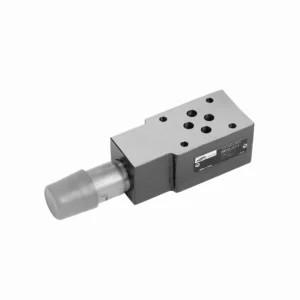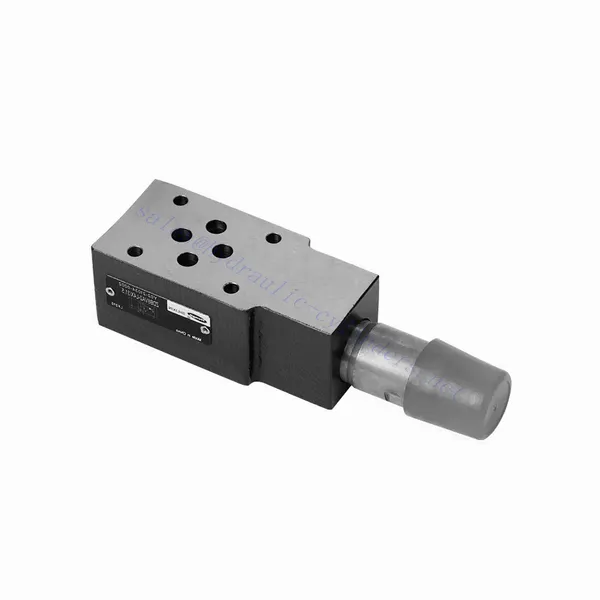ZDB/ZDBD Series Pilot Operated Pressure Relief Hydraulic Valve
Sebagai salah satu produsen, pemasok, dan eksportir silinder hidrolik, Kami menawarkan silinder hidrolik dan banyak produk lainnya.
Silakan hubungi kami untuk informasi lebih lanjut.
Surat:sales@hydraulic-cylinders.net
Produsen pemasok eksportir silinder hidrolik.
ZDB/ZDBD Series Pilot Operated Pressure Relief Hydraulic Valve

The ZDB/ZDBD series pilot-operated pressure relief hydraulic valve is a high-performance component that provides precise and reliable pressure control in hydraulic systems. With its advanced pilot-operated design and exceptional functionality, this valve ensures efficient and safe operation by regulating system pressure within desired limits.
The ZDB/ZDBD series pilot-operated pressure relief hydraulic valve is a high-performance solution for precise pressure control in hydraulic systems. With its pilot-operated design, pressure control accuracy, wide pressure range, and fast response time, this valve ensures efficient and safe operation while protecting system components. By following the recommended usage methods and maintenance practices, the ZDB/ZDBD series valve delivers reliable performance, extending the lifespan of hydraulic systems. Upgrade your hydraulic system with the ZDB/ZDBD series pilot-operated pressure relief hydraulic valve and experience optimal pressure control for enhanced system efficiency and productivity.
ZDB/ZDBD Series Pilot Operated Pressure Relief Hydraulic Valve Key Characteristics:
- Pilot-Operated Design:
- The ZDB/ZDBD series valve features a pilot-operated design, allowing it to deliver precise pressure control in hydraulic systems.
- It utilizes a control pilot to modulate the main valve, providing accurate and responsive pressure relief.
- Pressure Control Accuracy:
- This valve offers exceptional pressure control accuracy, ensuring the hydraulic system operates within desired pressure limits.
- It maintains consistent pressure levels, preventing over-pressurization and protecting system components.
- Wide Pressure Range:
- The ZDB/ZDBD series valve provides a wide pressure control range, making it suitable for various hydraulic applications.
- It allows customization to match specific system requirements and optimize performance.
- Fast Response Time:
- With its pilot-operated mechanism, the ZDB/ZDBD series valve exhibits a rapid response time to changes in pressure.
- It swiftly adjusts the flow path to relieve excess pressure, ensuring stable and reliable system operation.
ZDB/ZDBD Series Pilot Operated Pressure Relief Hydraulic Valve Parameter:
ZDB
| Specifications | NG6 | NG10 | NG16 | NG22 | ||||||
| Fluid | Mineral oil suitable for NBR and FKM seal | |||||||||
| Phosphate ester for FKM seal | ||||||||||
| Fluid temperature range | ℃ | -30 to +80 (NBR seals ) | ||||||||
| -20 to +80 (FKM seals ) | ||||||||||
| Viscosity range | mm2/s | 10 to 800 | ||||||||
| Degree of contamination | Maximum permissible degree of fluid contamination: Class 9. NAS 1638 or 20/18/15, ISO4406 | |||||||||
| Max. operating pressure | bar | to 315 | ||||||||
| Max.adjustable pressure | bar | 50; 100; 200; 315 | ||||||||
| Max. flow-rate | L/min | 60 | 100 | 200 | 400 | |||||
| Weight | kg | ZDB6 | Z2DB10 | ZDB10 | Z2DB10 | ZDB16 | Z2DB16 | ZDB22 | Z2DB22 | |
| about 1.2 | about 1.9 | about 2.7 | about 3.1 | about 9.4 | about 11.8 | about 9.2 | about 10.3 | |||
ZDBD
| Fluid | Mineral oil suitable for NBR and FKM seal | |||||||||||||||||||||
| Phosphate ester for FKM seal | ||||||||||||||||||||||
| Fluid temperature range | ℃ | -30 to +80 (NBR seals ) | ||||||||||||||||||||
| -20 to +80 (FKM seals ) | ||||||||||||||||||||||
| Viscosity range | mm2/s | 10 to 800 | ||||||||||||||||||||
| Degree of contamination | Maximum permissible degree of fluid contamination: Class 9. NAS 1638 or 20/18/15, ISO4406 | |||||||||||||||||||||
| Max. operating pressure | bar | to 315 | ||||||||||||||||||||
| Max.adjustable pressure | bar | 50; 100; 200; 315 | ||||||||||||||||||||
| Size | / | 6 | 10 | 16 | 22 | 32 | ||||||||||||||||
| Max. flow-rate | L/min | 30 | 80 | 160 | 250 | |||||||||||||||||
| Weight | Relief function | kg | A | B | C | D | A | B | C | D | A | B | C | D | A | B | C | D | A | B | C | D |
| 2 | 3 | 4 | 4 | 6 | 9 | 13 | 16 | 12 | 25 | 32 | 29 | 47 | 55 | 57 | 53 | |||||||
ZDB/ZDBD Series Pilot Operated Pressure Relief Hydraulic Valve Advantages:
ZDB NG6
• Sandwich type structure
• Installation face follows DIN 24340 A and ISO 4401
• Used in screw connection, Used for bottom sub-plate mounting
• Four pressure ranges
• 5 circuit options
• Two adjustment types: knob, adjustment screw with protection cap
ZDB NG10
• Sandwich type structure
• Installation face follows DIN 24340 A and ISO 4401
• Used in screw connection, Used for bottom sub-plate mounting
• Four pressure ranges
• 6 circuit options
• With one or two inserted overflow valves
• Two adjustment types: knob, adjustment screw with protection cap
ZDB NG16、22
• Sandwich type structure
• Installation face follows DIN 24340 A and ISO 4401
• Used in screw connection, Used for bottom sub-plate mounting
• Four pressure ranges
• 5 circuit options
• With one or two inserted overflow valves
• One adjustment type: adjustment screw with protection cap
ZDBD NG6-32
• Sandwich type structure
• Installation face follows DIN 24340 A and ISO 4401
• Used in screw connection, Used for bottom sub-plate mounting
• Three pressure ranges
• 4 circuit options
• With one or two inserted overflow valves
• One adjustment type: adjustment screw with protection cap
Usage Method Of ZDB/ZDBD Series Pilot Operated Pressure Relief Hydraulic Valve:
- System Analysis:
- Conduct a comprehensive hydraulic system analysis to determine the specific pressure control requirements.
- Consider maximum operating pressure, desired pressure range, and flow rates.
- Valve Selection:
- Select the appropriate ZDB/ZDBD series hydraulic valve variant based on the system’s pressure control specifications.
- Consider pressure rating, flow capacity, and compatibility with other system components.
- Installation:
- Follow the manufacturer’s instructions to correctly install the ZDB/ZDBD series pilot-operated pressure relief hydraulic valve in the hydraulic system.
- Ensure proper alignment and secure connection to prevent leaks and optimize performance.
- Pressure Adjustment:
- Adjust the valve’s control pilot to set the desired pressure relief level.
- Refer to the valve’s technical documentation for guidance on accurately adjusting the pilot pressure.
How Does A Hydraulic Priority Valve Work?
A hydraulic priority valve, also known as a flow divider or flow combiner, is a component used in hydraulic systems to allocate priority flow to specific circuits or actuators. Its primary function is to ensure that a predetermined amount of hydraulic fluid is supplied to a high-priority circuit or actuator before distributing the remaining flow to lower-priority circuits. Let’s explore how a hydraulic priority valve works:
- Valve Configuration:
- A hydraulic priority valve typically consists of a valve body, a spool, and various ports for fluid inlet and outlet.
- Flow Regulation:
- The priority valve receives hydraulic fluid from the main pump or power source.
- It regulates fluid flow based on the system’s specific requirements.
- Priority Port:
- The valve designates one or more ports as the priority port(s) where high-priority circuits or actuators are connected.
- These priority ports receive the initial flow allocation before the remaining flow is distributed to other ports.
- Spool Position:
- The position of the spool within the valve determines the flow distribution between the priority and secondary circuits.
- When the spool is in a neutral or centered position, the flow is blocked or restricted to all ports.
- Priority Flow Allocation:
- As hydraulic fluid enters the valve, it first reaches the priority port(s).
- The spool is designed to provide a predetermined flow rate to the high-priority circuit(s) connected to these ports.
- Remaining Flow Distribution:
- After the priority flow is allocated, the excess or remaining flow is diverted to the secondary ports connected to lower-priority circuits or actuators.
- The spool position allows the fluid to flow freely to these secondary circuits, ensuring they receive an adequate supply.
- Pressure Compensation:
- Hydraulic priority valves often incorporate pressure compensation mechanisms to maintain consistent flow rates regardless of load variations.
- These mechanisms adjust the spool position based on the pressure differential between the priority and secondary circuits.
Kemampuan & Kapasitas Pabrik:
(1) Perakitan
Kami memiliki platform perakitan penelitian dan pengembangan independen kelas satu. Bengkel produksi silinder hidrolik memiliki empat jalur perakitan silinder pengangkat semi-otomatis dan satu jalur perakitan silinder kemiringan otomatis, dengan kapasitas produksi tahunan yang dirancang sebesar 1 juta keping. Bengkel silinder khusus dilengkapi dengan berbagai spesifikasi sistem perakitan pembersihan semi-otomatis dengan kapasitas produksi tahunan yang dirancang sebesar 200.000 dan dilengkapi dengan peralatan permesinan CNC yang terkenal, pusat permesinan, peralatan khusus pemrosesan silinder presisi tinggi, mesin las robot, mesin pembersih otomatis, mesin perakitan silinder otomatis, dan jalur produksi pengecatan otomatis. Peralatan penting yang ada lebih dari 300 set (set). Alokasi optimal dan penggunaan sumber daya peralatan yang efisien memastikan persyaratan akurasi produk dan memenuhi kebutuhan produk berkualitas tinggi.


(2) Pemesinan
Bengkel permesinan dilengkapi dengan pusat pembubutan rel miring yang disesuaikan, pusat permesinan, mesin pengasah berkecepatan tinggi, robot pengelasan, dan peralatan terkait lainnya, yang dapat menangani pemrosesan tabung silinder dengan diameter bagian dalam maksimum 400mm dan panjang maksimum 6 meter.

(3) Pengelasan

(4) Pengecatan & pelapisan
Dengan jalur pelapisan cat berbasis air otomatis silinder kecil dan menengah, untuk mencapai bongkar muat robot otomatis dan penyemprotan otomatis, kapasitas desain 4000 buah per shift;
Kami juga memiliki lini produksi cat semi-otomatis untuk silinder besar yang ditenagai oleh rantai daya, dengan kapasitas desain 60 kasus per shift.


(5) Pengujian
Kami memiliki fasilitas inspeksi kelas satu dan test bed untuk memastikan bahwa kinerja silinder memenuhi persyaratan.

We are one of the best hydraulic cylinder manufacturers. We can offer comprehensive hydraulic cylinders. We also provide corresponding gearbox pertanian. Kami telah mengekspor produk kami ke klien di seluruh dunia dan mendapatkan reputasi yang baik karena kualitas produk dan layanan purna jual kami yang unggul. Kami menyambut pelanggan di dalam dan luar negeri untuk menghubungi kami untuk menegosiasikan bisnis, bertukar informasi, dan bekerja sama dengan kami!
Ikuti Tur Pabrik VR Kami:
Ikuti tur ke pabrik VR kami dengan yang berikut ini
Aplikasi Silinder Hidraulik:


